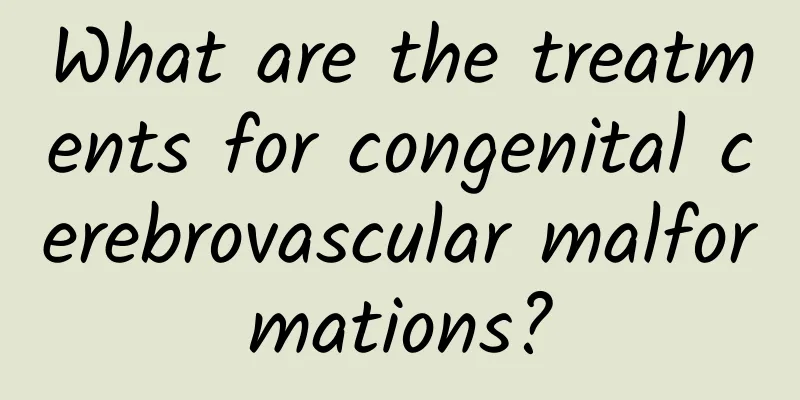What are the treatments for congenital cerebrovascular malformations?

|
Congenital cerebrovascular malformation is a hereditary disease, and also a relatively serious disease that is difficult to treat. Generally speaking, there are three treatment methods for congenital cerebrovascular malformations: interventional treatment, comprehensive treatment and conservative treatment. Of course, different therapies are suitable for different patients, and there are certain differences in treatment effects. Below, I will introduce three treatments for congenital cerebral vascular malformations. 1. Interventional treatment There are many treatments for congenital cerebrovascular malformations, including conservative treatment, radiotherapy, artificial embolization, supplying artery ligation and lesion resection, laser resection, etc. In the past, there was controversy over surgical or non-surgical treatment. From long-term observations, surgery has better effects, so surgical treatment is generally advocated. However, the specific method to be adopted needs to be considered comprehensively based on many factors such as the patient's specific physical health condition, the location of cerebrovascular malformation, complications, etc., so it cannot be generalized. The purpose and significance of the treatment of congenital cerebrovascular malformations are: ① Completely eliminate the lesions through intravascular embolization and restore the normal blood supply to the brain tissue; ② For large cerebrovascular malformations, embolization can reduce their size, thereby reducing the chance of cerebral hemorrhage and epileptic seizures, and helping to control the clinical condition; ③ Embolization can also be used as an auxiliary means of surgery and create conditions for stereotactic radiotherapy. The method of intravascular embolization therapy is to insert a microcatheter into the abnormal vascular mass and inject an embolic agent. Medical glue is generally used to embolize the abnormal blood vessels to achieve the purpose of treatment. 2. Comprehensive treatment Depending on the specific circumstances of congenital cerebrovascular malformations, two or more methods are selected for combined application. For example, embolization therapy can be used first to reduce the size of the abnormal vascular mass, or to reduce the risk of overperfusion, and then surgery or gamma knife treatment can be performed; residual vascular malformations after surgery can be treated with gamma knife; or vascular malformations that are not occluded after gamma knife treatment can also be treated surgically, and so on. 3. Conservative treatment Conservative treatment can be considered for patients who are older, have only epileptic symptoms that can be controlled by medication, are located in important functional areas of the brain, are deep in the brain, or have extensive lesions. Let patients understand the natural disease process of AVM, try not to affect their work and life, guide patients to maintain good living habits and regularity, avoid excessive fatigue and excitement, control blood pressure, give anti-epileptic and other symptomatic treatments, etc. |
<<: What are the complications of congenital cataracts?
>>: Three major symptoms of congenital amblyopia
Recommend
What are the symptoms of intestinal damp heat
Intestinal damp-heat is a term in traditional Chi...
What are the benefits of drinking honeycomb wine for a long time?
Everyone knows that honey is a delicacy and can a...
What is the best season to drink Chinese medicine?
As the saying goes, "Good medicine tastes bi...
How to clean intestinal waste and oil
Now that the living standards have improved, many ...
Swelling of the nasal mucosa
The nasal mucosa is an important component of the...
How to treat ameloblastoma
In real life, whenever we talk about tumors, ever...
What medicine can men use to get an erection immediately?
For male friends, reproductive organs are very im...
What should I do if my facial skin turns yellow? How to improve?
Many women after the age of 25 will find that the...
The song of the fun formula of Jinzhengqi San
If Jin Haoran's Zhengqi Powder is not changed...
Will eating loquats during breastfeeding cause milk to dry up?
Some people think that new mothers who are breast...
What causes dizziness and heavy eyelids?
Dizziness and heavy eyelids may be caused by lack...
What ointment is good for anal itching
There are many causes of anal itching. It may be ...
What ointment is good for rose rash
After getting pityriasis rosea, you can use some ...
Why do newborn babies have eczema?
The period when eczema is triggered mostly occurs...
Symptoms of potassium deficiency in the human body
With the continuous improvement of modernization,...









